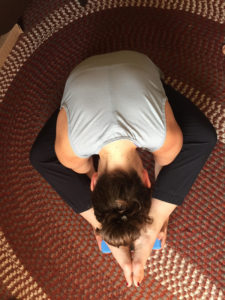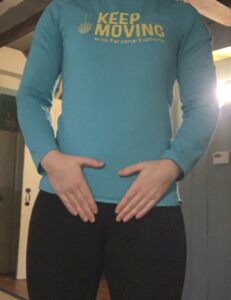Note: this post was written April 2022 (info is changing quickly in COVID).
According to a health data scientist at the Indiana University School of Medicine, struggling to return to exercise is one of the biggest complaints of individuals with long covid along with brain fog and fatigue.
Exercising When Sick 
As a general rule any time we exercise we need to listen to our body. This is even more true as you return to exercise after a bout of COVID. It’s important to listen to your body because no rule is steadfast or one size fits all. I have friends that, prior to COVID, swore that when they were sick exercise helped them get over illness. I’ve never found that to be true in my body. When I’m sick I need rest or I get worse—even for a minor head cold. So you need to know your body and what you need.
COVID aside, the general rule for exercising when sick has been if you feel illness in your head region, do what you can do. If you feel it in your chest take a break from exercise. Again, I’ll point out that I’d personally take a break for a head cold. I know I’m more likely to get something worse if I push through.
Exercising with COVID
With COVID the general guidelines, prior to Omicron, was to take a two week break after symptoms cleared. Even with mild symptoms some people were showing inflammation in the heart, lungs, and other organs so the guideline was basically there to say, don’t risk it and give your body a chance to heal if it needs it. I have not seen new generalized guidelines since Omicron, which has caused milder cases than earlier variants.
In asymptomatic to mild cases, guidelines said to ease back into exercises slowly and see how it feels. For severe cases, guidelines recommended seeing a cardiologist first. If you feel chest pain, chest tightness, an irregular heartbeat, lightheaded, abnormal shortness of breath it’s recommended you have a chat with your doctor to make sure everything is okay.
Exercising with Long COVID
After two clients (both vaccinated, regular exercisers, who had COVID to varying degrees) mentioned that they returned to exercise and had a lingering symptom in their chest, I started researching. One of my clients mentioned that it was hard to explain, but she sort of felt winded when she exercised, but she could still do it.
What was available on the topic was minimal. It’s still unknown, however there are indications that it is not merely deconditioning of the body or damage to the heart or lungs. In a small study of about 20 people it appeared their veins and arteries weren’t working properly which prevented the muscles from getting enough oxygen. It’s uncertain what causes this, but it might be due to a nerve fiber not working.
This leads to a debate about whether people with this symptom should exercise. No one seems to know.
As someone who is always trying to encourage people to move, it’s hard for me to envision a world where exercise is not a good choice long term. But that doesn’t mean you may not need to alter your exercise and try some more gentler options. Perhaps walking instead of running or running for shorter periods and listening to how your body feels.
Sometimes we do require rest, but movement can help the body heal and repair too. It’s just about choosing the right movement at the right time. So, if exercise doesn’t feel the same since you’ve had COVID, talk to your doctor and consider altering your routine to build back up a little slower. Also, trust that long term symptoms may not last forever, so this too may pass.
Keep Reading
It might be hard to stop exercising, but it may be your in your best interest. Learn how to rest and do nothing with Maggie!
Click here to hear Maggie’s motto about listening to your body!
Keep Connected
Order Your Copy of Keep Moving Today!
Subscribe to the Keep Moving Blog
Like the Personal Euphoria Facebook page
Find us on Twitter
Follow me on Instagram
Subscribe to my YouTube Channel
